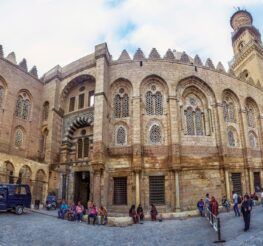The Complete Development Guide for the Giza Pyramids
Ancient Hitory Culture Development egypt history The Great Pyramids of Giza
May Mansour
Image credit: Sky News Arabia
Every inch at The Pyramids of Giza carries a fascinating story from the history of Egypt. Still, despite the importance of the place, it has suffered from great neglect, especially in the past few years. Serious measures have begun to restore the marvel and sophistication of the Pyramids of Giza, part of the ancient city of Memphis, Egypt’s capital since the Old Kingdom and up until the start of Alexander the Great’s rule.
The archaeological site includes the Great Pyramid of King Khufu, which is one of the Seven Wonders of The Ancient World, in addition to 38 pyramids in Giza, Saqqara, Abu Sir, and Dahshur, and about 9,000 relics and tombs from different periods from the First Dynasty all until the Greco-Roman era.

A recent report published by Sky News states that the Egyptian government’s development plans aim to restore the pyramids’ historical image and maximise its archaeological value. The goal is to convert the archaeological sanctuary at the Giza pyramids plateau into an open museum and connect it to branches of the Nile River, as well as build a hotel north of the Grand Egyptian Museum and north-east of the Mina House Hotel. And finally, establish tourist services at the bottom of the pyramids plateau.
In an interview with Sky News, the General Director of the Antiquities of the Pyramid, Ashraf Mohi El-Din says that the development includes moving the entrance to the archaeological area from the current entrance next to the Mina House Hotel to the Fayoum Road, so that visitors enter through the desert and avoid traffic. There will also be a huge parking area by the new entrance, ready to receive more than three thousand buses and cars, according to Sky News Arabia.

As for movement within the archaeological area, the Director-General of the Antiquities Zone of the Pyramids states that the ticketing area will be divided into three sections: one for foreigners, one for Egyptians, and a designated area for people with special needs where there will be paths and toilets of their own.
The new project aims to begin the tour inside the visitors centre, which includes a cinema hall that will display a seven-minute film that narrates the history and excavations of the archaeological area, as well as a “Maket” in the middle of the centre, which is an embodiment of the pyramids and ancient tombs.
Once out of the VIP hall, visitors will find an electric bus which will take them on a journey through six stations inside the archaeological site starting from the visitor centre, passing around the first, second, and third pyramids, reaching the Sphinx and then returning to the visitor centre again. The waiting period will not last more than four minutes between one bus and the next.
Services will also be available near the new entrance; including a police station for tourism and antiquities, a civil defence building, an ambulance station, an administrative building for antiquities inspectors, in addition to several restaurants, the first of which was recently opened, the Nine Pyramids Lounge, which is considered the first environmentally friendly restaurant.
And to solve a problem that bothered visitors in the past, 30 portable toilets equipped with water tanks in accordance with the nature of the archaeological area, internet services will also be provided, along with a phone app that explains the archaeological sites and clarifies maps of the entire area. Improvements of all roads leading to the pyramids will also be made, including a tourist walkway, and removing part of Nazlet El-Semman to reveal the valley temple and the city of workers under the area, as well as resettling and compensating people who live there. The area is expected to open in mid-2021, coinciding with the opening of the Grand Egyptian Museum.
Read the story in Arabic here.
recommended
 Arts & Culture
Arts & Culture
The Coptic Museum: The History of Egypt to the Tunes of Psalms of David
arts & culture cairo museums +4 Health & Fitness
Health & Fitness
Egyptians in the 2024 Summer Olympics
Egyptians in the Olympics Olympics +1 City Life
City Life
Weekend Guide: Bazar by Sasson, Memo, The Cadillacs, Heya Bazaar, Dou, Nesma Herky & More
Concerts The Weekend Guide +2 Arts & Culture
Arts & Culture

